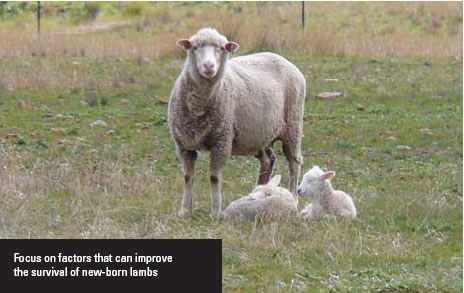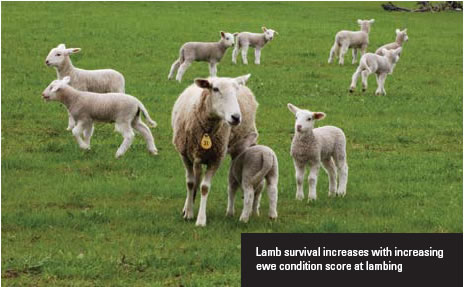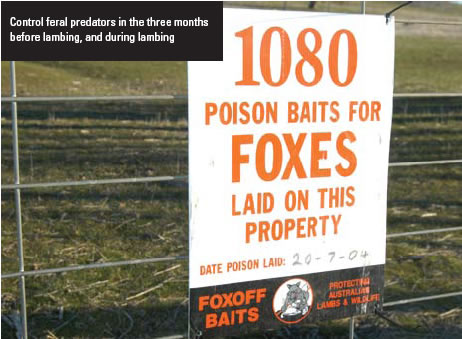 |
 |
Select a lambing time likely to maximise survival of new-born lambs.
|
 |
Manage ewe density and mob size for best lambing results.
|
 |
Early selection and pasture preparation in lambing paddocks ensures that lambs reach target weaning weights. |
|
 |
Introduction
Important principles to increase lamb survival are:
-
Select a lambing time that is likely to maximise survival of new-born lambs.
-
Ewe condition at lambing is the most important determinant of lamb survival, due to its effect on lambs birth weights.
-
Cold, wet and windy weather increases lamb mortality, particularly with lambs that have a low birth weight. Manage ewes to minimise the impact of weather at lambing. Plan to have sheltered paddocks available for lambing.
-
Early selection of lambing paddocks on the basis of size, availability of shelter, and pasture quality and quantity available for ewes are critical management decisions affecting the ability to wean more lambs.
-
The effects of prolonged birth and the combination of hunger and mismothering account for the majority of lamb deaths.
-
If ewe nutrition is poor, there is delayed production of colostrum and new-born lambs are at risk if they do not receive a drink soon after birth. In addition, mothering ability and lamb behaviour are depressed when ewe nutrition is poor.
- The longer a ewe stays at the birth site, the greater the chance of the ewe and lamb forming a bond.
- Depending on the individual ewe and the breed type, it takes up to six hours for a ewe to recognise her lamb and in this time a ewe may accept any lamb as her own. It also takes lambs twice as long to recognise their mothers and if a lamb is abandoned within six hours of birth it has little chance of survival. Merino ewes do not recognise twins very well.
- Ewes about to give birth may ‘pirate’ recently born lambs only to abandon them when their own lamb is born.
- When the number of ewes lambing is at its peak, the lambing paddock is a busy and cluttered place. Best practice is to minimise any disturbance in the lambing flock.
- Predators can account for between 5–10% of losses in some situations. But predators are usually of secondary importance compared with hunger, mismothering and hypothermia.
- When predators are known to cause lamb loss, start baiting well before lambing and continue until well into lambing.
Key decisions, critical actions and benchmarks
Lamb survival rate targets

Lambing management needs to aim for lamb survival better than:
As ewe condition score at lambing increases, so does lamb survival, especially in twin bearing ewes. In the period from three days after birth to before weaning, aim to keep lamb death rates at less than 3%.
Selection of lambing paddocks
Several key features need to be considered when selecting lambing paddocks.
Pasture availability targets
The following pasture targets provide a guide to best practice:
|
Twin lambing low condition score
|
best pasture/ best shelter
|
|
Twin lambing high condition score
|

|
|
Single lambing low condition score
|
|
Single lambing high condition score
|
least pasture / most exposed
|
Lambing paddock shelter
The factors contributing to the risk of hypothermia in lambs include combinations of temperature, rainfall and wind speed. Of these, only wind speed can be controlled by using naturally sheltered lambing paddocks. As a guide, sheltered paddocks can reduce lamb mortality rates by about 10% but shelter will provide less benefit if lambing in location/seasons with mild weather.
Ideally, lambing paddocks that are sheltered from the prevailing winds and provide shelter over the entire paddock are best for lambing. Satisfactory shelter can be provided by trees, shrubs and tussocks. It is important that shelter belts are designed properly otherwise they may act as wind tunnels when grazing livestock remove the foliage from the lower branches (see procedure 5.3 in Protect Your Farm’s Natural Assets).
When selecting lambing paddocks, consider the sheep grazing behaviour and paddock characteristics and avoid those where ewes are likely to lamb in exposed areas. Preferred paddocks are north and east facing, have good sunlight in the morning, are well drained and provide good access to water.
Paddocks with low worm risk
In high rainfall regions, gastrointestinal parasites are a major cause of production loss in ewes and poor growth in lambs. Ideally, graze ewes on paddocks with low worm contamination during lambing. Worm management is discussed in procedure 11.2 in Healthy and Contented Sheep.
Paddock and mob size
The most important consideration is to stock lambing paddocks to match pasture availability with breeding ewe demand (see tool 7.6 in Grow More Pasture for a range of pasture assessment tools). As a general guide, keep stock densities under
18 ewes/ha in twin lambing paddocks. A smaller mob size will also improve lamb survival, most probably due to lower incidence of mismothering.
These are only guides and many other factors must be considered, including the cost of subdivision and management issues with extra mobs.
Table 10.2 Suggested mob sizes
|
Flock type
|
Maximum recommended flock size
|
|
Twin bearing mature ewes
|
100–250
|
|
Single bearing mature ewes
|
400–500
|
|
Single bearing maiden ewes
|
250–400
|
Predator control
The main predators of new-born lambs are foxes and in some regions, wild dogs and pigs. In some circumstances predators can kill more than 10% of lambs.
If foxes are a problem, baiting in the three months before lambing and during lambing, is recommended (see tool 5.11 in Protect Your Farm’s Natural Assets). Pig predation is best managed by selecting lambing paddocks where pigs can be controlled.
Investigating neonatal lamb deaths
Investigate excessive new-born lamb losses and discuss with your animal health or livestock adviser. Tool 10.8 contains a check list to diagnose common causes of lamb losses so you can improve management to reduce deaths in future years.
Supervision during lambing
Best practice is to minimise the disturbance of the lambing flock. If supervision is warranted, the best time to enter the maternity paddock is in the early afternoon. Develop a routine so ewes will become accustomed to human presence and will not leave their lambs. Injured ewes/lambs should be assisted or humanely destroyed.
Lamb marking and mulesing
Losses associated with marking are normally less than 1%. Time marking and mulesing for about two weeks after the last possible lambing date. Hygiene is most important for equipment.
Conduct mulesing in accordance with industry guidelines using an accredited operator (see signposts). If mulesing is conducted when flystrike is possible, treat lambs with a product to prevent flystrike on healing wounds.
Carry out marking and mulesing in clean yards close to the paddock being grazed and ensure the operation is completed early in the day so ewes and lambs can successfully mother up.
For guidelines on additional health treatments, refer to procedure 11.5 in Healthy and Contented Sheep.
Nutritional management of lambs until weaning
To achieve target weaning weights ewes and lambs need to graze high-quality pasture. Pasture quality (especially legume content) and quantity are the best indicators of potential lamb growth rates.
In mixed perennial pastures - if pasture availability falls below the critical limit of 1,000 kg green DM/ha or in annual based pastures below 1,200 FOO after the start of lambing, supplementary feeding may be necessary. Mismothering losses due to feeding are likely to be lower if paddocks and mob sizes are smaller.
When available feed resources are low, consider identifying ewes that have lost their lambs or failed to lamb, at marking and remove them to save pasture for lactating ewes. Dry ewes can be managed separately or sold.
Imprint feeding lambs before weaning
Train lambs to feed supplements by ‘imprint’ feeding before weaning. Feed lambs at least 4-5 times while with their mothers using the supplement most commonly used on the farm at a low rate. The idea is to introduce the lambs to feed so they can recognise the supplement after they are weaned.
This is an important management strategy that reduces the period taken to train sheep to eat a supplement once they are weaned.
Signposts  |
Read
Managing Ewes in late pregnancy - Practical Wisdom notes, Sheep CRC. Click here to download.
More Lambs More Profit - download here (1MB)
National Mulesing Accreditation Manual – details the preparation and planning, mulesing equipment, chemical and animal health product use and mulesing procedures that meet the welfare standards in the Code of Practice for the Welfare of Animals: the Sheep. To receive a copy of the manual from AWI, or to register for the National Mulesing Accreditation Program (NMAP), call 1800 221 076.
EverGraze Fact Sheets. EverGraze is
developing and testing new farming
systems in different environments
across the high rainfall zone of southern
Australia. Download the fact
sheets listed below from http://www.evergraze.com.au/ and use the library search function on the home page to search by topic and keyword.
- EverGraze Exchange - Improving
survival of lambs (588kb)
- EverGraze Action - Perennial grass
hedges provide shelter at lambing
(492kb)
View
FeralMone™– a spray-based lure designed to increase visitation of wild dogs or foxes to bait or trap sites and to assist in bait uptake. Feralmone™ is available from rural merchandisers and agencies responsible for fox and wild dog control programmes (all state agencies except Department of Primary Industries Victoria or Dept of Agriculture & Food WA).
The PestSmart Toolkit (www.pestsmart.org.au/) provides information and guidance on best-practice invasive animal management on several key vertebrate pest species including rabbits, wild dogs, foxes and feral pigs. Information is provided as fact sheets, case-studies, technical manuals and research reports. Also, view the PestSmart YouTube Channel (www.youtube.com/PestSmart/) for video clips on best practice control methods for pest animal management.
Attend
Lifetime Ewe Management – the workshop focuses on the health issues associated with the Merino ewe and develops sheep producers' skills in sheep assessment and feed budgeting. Contact the Rural Industries Skill Training (RIST) centre on:
Bred Well Fed Well, is a practical, one day workshop highlighting the key production benefits of superior genetics, plus feed management for improved reproductive performance and livestock productivity. https://www.mla.com.au/extension-training-and-tools/Bred-Well-Fed-Well/
Apps
Lifetime Ewe Management: available for iOS and Android. Based on LTEM course. Requires knowledge of condition scoring and feed on offer to use and assists in feed budgeting.
|
.
|